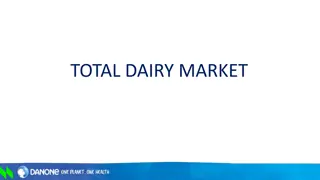Options for Improved Manure Management in Small-Scale Dairy Systems
Explore various options for integrated manure management in intensive small-scale dairy systems, focusing on collection, storage, and improvement practices. Learn about strategies to reduce nutrient loss and minimize environmental impact through effective manure handling techniques.
- Manure management
- Dairy systems
- Integrated management
- Environmental sustainability
- Nutrient conservation
Download Presentation

Please find below an Image/Link to download the presentation.
The content on the website is provided AS IS for your information and personal use only. It may not be sold, licensed, or shared on other websites without obtaining consent from the author. Download presentation by click this link. If you encounter any issues during the download, it is possible that the publisher has removed the file from their server.
E N D
Presentation Transcript
Improving manure management Module 3. Options for manure management in intensive small- scale dairy systems
Learning objectives of Module 3 1. Understand meaning of integrated manure management and its criteria 2. Know which options for integrated manure management are feasible for small- scale intensive dairy systems
Integrated manuremanagement for small-scale intensive dairy systems Manure management is management of the whole manure chain : integrated manure management Storage Application Collection Treatment Options for improving manure management should: o take into account collection, storage, eventual treatment and application and/or use of the manure o focus on reducing loss of nutrients and negative environmental effects o consider the feasibility and economy of the options.
Options for improved manure management Collection Storage Key points for improvement of collection and storage: Type of barn: tied barn, loose housing system, deep litter system Type of floor: earthen floor,sandy or concrete floor of walking area Roofing of the barn/shed: partial roofing or complete roof Frequency of manure removal, collection
Options for improved collection Areas of manure production Areas of improvements Improvements Practices of improvements Solid floors Increasing the slope of the walking floor Using gutters to drain the urine Floor Barn Roofing the confinements, including the walking area Roof Regular manure collection Separation of manure liquid and solid fractions Feedlot Improved collection practice should: Ease manure collection Reduce losses via spills, leaching/drainage Confinement
Separate collection of liquids and solids Reduces loss of nutrients (less ammonia volatilization) Requirements: Investments in separate storages and extra labour (collection) Methods: 1.Separate collection at time of excretion 2.Partial separate collection of liquids and solids in barn: Draining of liquids on sloping floor to a liquid storage Collection of solids from the floor
Options for improved storage (1) Good storage of manure will reduce nutrient losses and reduce bad smell Options for effective storage of slurries and liquids: Closed, concrete walled pits or tanks Urine concrete pit Slurry concrete pit Manure solids storage
Options for improved storage (2) Storage Use of protective covers on manure heaps and piles will reduce nutrient losses Options for protective covers on heaps and piles: (Semi)-permanent covers: plastic covers (cheap) Permanent cover: roofed shed (relatively high investment) Temporary covers: banana leaves, straw (short lived) Temporary Semi-permanent Permanent
Options for improved manure management Collection Treatment Reasons for treatment of manure : Production of a valuable product, e.g. biogas or compost Improvement handling (reduction of volume, moisture) Reduction of nutrient losses Reduction of risk human infections (e.g. killing of pathogens) and/or weed seeds Options: Biodigestion, drying (dehydration), physical separation, composting and refining
Options formanure treatment (1): biodigestion Anaerobic digestion process in biodigester: breaking down of manure (organic matter) Production of energy: biogas (methane) and digestate (bioslurry) Bioslurry: organic fertilizer has low dry matter content, less organic matter and higher mineral N content than original manure
Options for manure treatment (2): air drying (dehydration) Air drying: Evaporation of moisture to improve volume and handling Most applicable for moist manures: slurry and bioslurry Advantages: End product is easy to handle and transport Reduction of odour Disadvantages: Risk of drainage of nutrients during drying Losses of mineral N (volatilization) Difficult during rainy season
Options for treatment (3): mechanical separation Collection Treatment Mechanical separation Mechanical treatment of slurries with manure separator into a liquid and a solid fraction The solid fraction: a stackable organic fertilizer, easy to store and to transport (e.g. for sale) Liquid fraction: fertilizer for crops and in fish farming Liquid fraction contains more N and solid fraction more P Disadvantage: relative high investment (separator) Suitable for larger farms with surplus of manure
Options for manure treatment (4): composting Aerobic composting: Natural process of decomposition by microorganisms: suitable reduction of volume and moisture Suits all farm situations (large, small) and all types of manure End product: stable (moisture content, nutrients), easy to handle free of pathogens and viable weeds (aerobic composting) Requirements: Availability and addition of other organic materials (green, dry) Disadvantages: Labour intensive Nutrient losses (C,N) can be high Collection
Options for improved manure management Collection Treatment Application If possible, take sample of manure for lab analysis to determine nutrient content Apply manure based on nutrient content and according to crop needs to avoid overfertilization If separate collection of liquids and solids, allocation could be the following: Regular application of liquids (during weeding) on forage crops Application of solids on land (during cultivation) for food crops/cash crops Incorporation of manure-slurry into the soil (mixing) at or directly after application: Reduction volatilization of ammonia (N) Better utilization of nutrients by the crop Distribute manure evenly over the land or crop
Options for improved manure management: Summary Nutrient losses - - - Fertilizer value - - - Extra labour 0 Invest- ment Effect on environment - - - Expected profitability Options Baseline: uncovered heap, no roofing walking area barn 0 +- Heap covered with plastic sheet - - - - + + - - ++ Roofing and closed storage ++ ++ + ++ ++ + Direct separation liquid solids, closed storage +++ +++ +++ ++ +++ +- ? Partial separation liquid solids, closed storage ++ ++ ++ ++ ++ +- ?
Options for improved manure management: Summary Options Nutrient losses Fertilizer value Labour Invest- ment Effect on the environment Expected profitability Mechanized separation ++ ++ + +++ ++ ? Slurry Composting slurry/manure +- + +++ ++ + ? Drying dung/ solid fraction +- + ++ + + + Vermi culture ? + ++ ++ ++ ?























